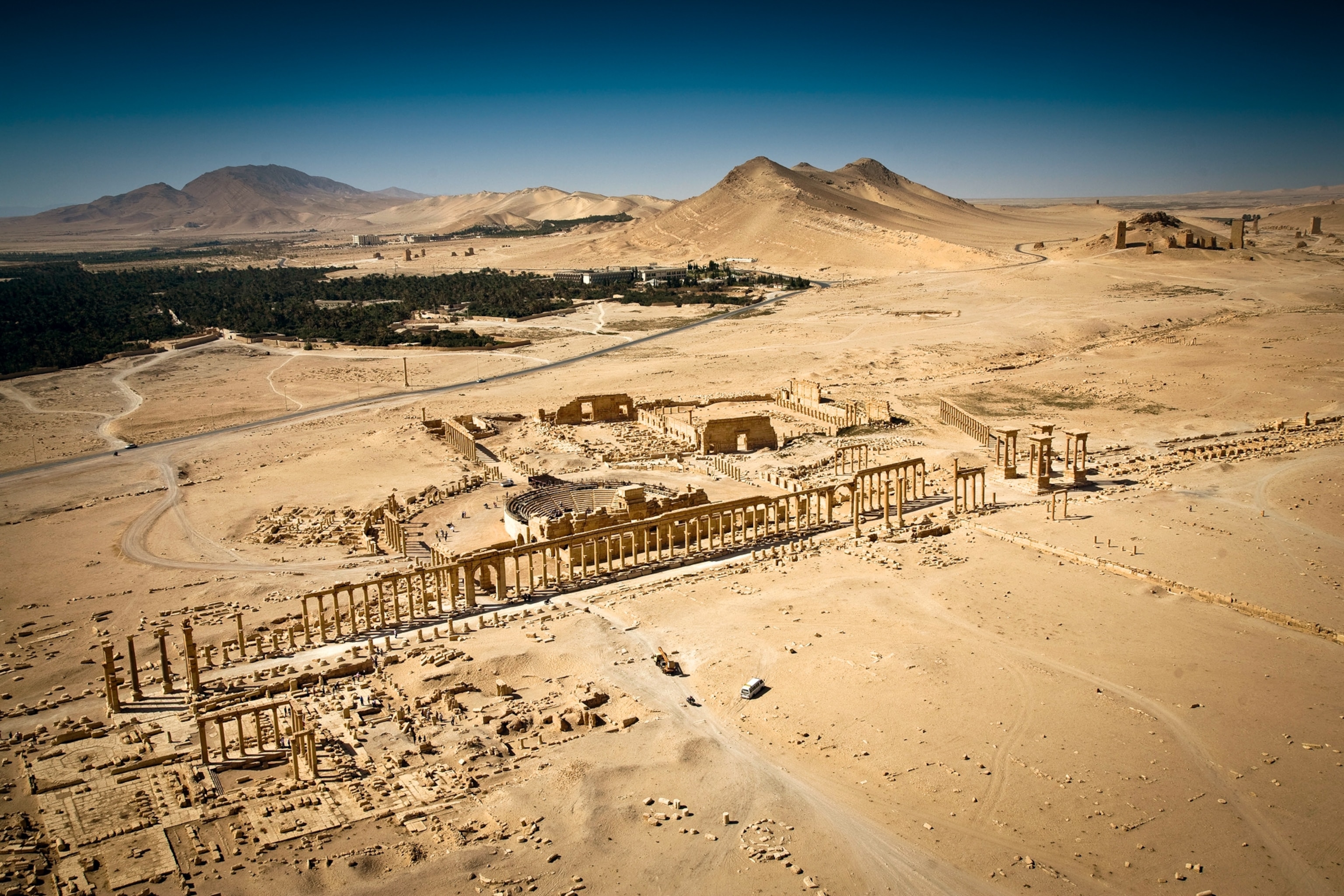
Zenobia, the Rebel Queen Who Took On Rome
This ancient queen of Palmyra conquered Egypt, captured Roman provinces, and nearly transformed her realm into an empire equal to Rome.
Wealth, culture, and power dwelled in the city of Palmyra in the third century A.D. This cosmopolitan capital of the Roman province of the same name lay close to the empire’s eastern borders, providing the setting for Queen Zenobia’s ambitious power play.
The showdown had been decades in the making. By the middle of the third century A.D. the Roman Empire was mired in political and economic crisis, its frontiers under constant attack, and its center struggling to hold. The catastrophic defeat and capture in 260 of Emperor Valerian by the Persians thrust Roman rule into even greater disarray. In Europe the rebel Gallic empire started to break away from Rome. Weakened and distracted, the empire was facing threats on all fronts. Observing from the east, Zenobia saw her opportunity and knew that she had an empire to gain.
Palmyra had a history of cooperation with Roman rule, and this had resulted in many benefits for the desert kingdom. Located in the middle of modern-day Syria, around 130 miles northeast of Damascus, Palmyra had prospered since coming under Roman control in the first century A.D. Sitting at the crossroads between the Mediterranean world ruled by Rome and the great empires of Asia, it became a center of huge strategic and economic importance.
Grandeur of Palmyra




An obligatory stopover for the caravans that traversed the deserts, the wealth flooding into Palmyra gave its rulers the means to beautify their city, as well as the confidence to assert themselves regionally. Known as the “pearl of the desert,” the oasis city was famed for its magnificent buildings, such as its Arch of Triumph and an impressive theater. By the middle of the third century the Palmyrene empire was already enjoying a certain independence—albeit as a client state within the Roman Empire. Zenobia sought to change that.
Queen Takes Egypt
Over the centuries, Zenobia’s life story has been subjected to a great deal of scholarly speculation. The colorful but unreliable Augustan History, a late Roman collection of biographies, states that Zenobia associated herself with the Ptolemies of Egypt, including Cleopatra. Eastern historians, such as the ninth-century Persian al-Tabari, believed that Zenobia was not Greek but of Arab descent. Modern historians agree that the queen of Palmyra did not descend from the Ptolemies and most likely came from an influential Palmyrene family in which she had been well educated.

Little is known of her exact upbringing and education. Drawing on sources from the Roman Empire, the 18th-century British historian Edward Gibbon penned detailed descriptions of her in his six-volume classic, The History of the Decline and Fall of the Roman Empire:
Modern Europe has produced several illustrious women who have sustained with glory the weight of empire; nor is our own age destitute of such distinguished characters . . . Zenobia is perhaps the only female whose superior genius broke through the servile indolence imposed on her sex . . . Zenobia was esteemed the most lovely as well as the most heroic of her sex . . . Her manly understanding was strengthened and adorned by study. She was not ignorant of the Latin tongue, but possessed in equal perfection the Greek, the Syriac, and the Egyptian languages.
Zenobia married Odaenathus, a Romanized Arab and ruler of Palmyra. Reigning from 263, Odaenathus successfully defended Palmyra from the Persians, who were riding high after their humiliating defeat of Emperor Valerian. Remaining loyal to Rome—outwardly at least—Odaenathus managed to break through the Persian lines and force them to retreat to Persian territory.

From the outset, Odaenathus claimed to be acting on Rome’s behalf, but it soon became clear that he wanted to establish himself as “monarch of the East.” Given Rome’s tenuous position, the new emperor—Valerian’s son, Gallienus—had little choice but to acknowledge the powerful status of Odaenathus. Already boasting several titles awarded by Rome, including corrector totius Orientis (governor of the entire East), Odaenathus was also crowned “king of kings” by his own people. Palmyra might have become the capital of a new empire, but it was not to be. Odaenathus’s ambitions were thwarted by a palace intrigue in 267. On returning from a campaign against the Goths in Cappadocia (central Turkey), a relative murdered him in his palace.
Zenobia’s moment had arrived. Her son by Odaenathus, Wahballat (Vaballathus in Latin) was the heir, but still a child. Zenobia declared herself regent, a move that allowed her to seize control of territories in the east, recently taken from the Persians. She executed the parties responsible for her husband’s death, and then set to end the fiction that Palmyra and its domains were submissive to the Roman Empire and its emperor. Zenobia knew how to take advantage of the Roman Empire’s moment of weakness. She scorned Emperor Gallienus and his generals, who were powerless to stop her. When the next, short-lived Roman emperor, Claudius Gothicus, acceded, he had no choice but to recognize her sovereignty. Zenobia had achieved her aim: to make Palmyra an equal to Rome.
Little by little, with astuteness and the wise advice of her counselors, Zenobia widened the break with Rome. Keeping the Persians at bay to the east, she annexed various neighboring states, including all of Syria and most of Anatolia (modern-day Turkey). In 269 she sent her forces into Egypt and seized Alexandria. By 270 she had taken control of all of Egypt, its wealth, and the grain it supplied to Rome. Her empire looked unstoppable.

Meeting Her Match
Rome’s next emperor of consequence, Lucius Domitius Aurelianus, was a very different kind of adversary. Taking power in 270, Aurelian possessed a rigid military discipline forged in battle on the imperial frontiers. His ferocity on the front line was legendary, giving rise to a verse of a song in Latin: “Mille, mille, mille occidit!—A thousand, a thousand, a thousand he’s killed!” During the four brief years of his reign, this hardened soldier won his predecessors’ war with the Goths, repelled a barbarian invasion of northern Italy, and restored Roman rule in the unruly provinces of Gaul, Britannia, and Hispania.
Zenobia’s growing power and open defiance of Roman authority, especially following the declaration of her own son as Caesar in 271, could not help but attract Aurelian’s attention. The challenge she presented far exceeded that of a male ruler gone rogue: “Now all shame is exhausted,” the Augustan History lamented, “for in the weakened state of the [Roman] commonwealth things came to such a pass that . . . a foreigner, Zenobia by name . . . proceeded to cast about her shoulders the imperial mantle [and ruled] longer than could be endured from one of the female sex.”
Aurelian retaliated, taking back territory from Zenobia as his legions advanced through Asia Minor. Near Antioch, her army of 70,000 men made a stand, but after Aurelian’s forces defeated them, the remaining soldiers retreated to Palmyra. Aurelian’s legions pursued them and arrived at the city walls in 272.

They laid siege to Palmyra, but Zenobia was confident that her archers and cavalry could repel them. If that did not work, perhaps the Romans would succumb to hunger and the merciless desert climate. According to the Augustan History, the queen fired off a message full of characteristic defiance: “From Zenobia, Queen of the East, to Aurelian Augustus . . . You demand my surrender as though you were not aware that Cleopatra preferred to die a queen rather than remain alive, however high her rank.”
Stung by this rebuff from a woman, Aurelian redoubled his efforts to take the city. In desperation, the queen tried to flee eastward to Persia but was captured—the Augustan History relates—when she reached the Euphrates River. The city soon surrendered.

Zenobia’s Legacy
Much like her birth, the exact circumstances of Zenobia’s death are uncertain. Some Arab sources say that she committed suicide to avoid capture. Roman sources claim that Aurelian, unwilling to put a woman to death, brought her as a captive to Rome. The queen, it was said, had always longed to visit Rome, “and this hope was not unfulfilled,” the Augustan History recorded with irony: “for she did, indeed, enter the city . . . but vanquished and led in triumph.” Some sources claim she was decapitated there. Others recount that she married a Roman senator and lived out her life as a Roman matron. Whatever befell her, Zenobia has captured the imagination of generations of writers, enthralled by the exploits of this powerful queen who defied Rome.
You May Also Like
Go Further
Animals
- What rising temperatures in the Gulf of Maine mean for wildlifeWhat rising temperatures in the Gulf of Maine mean for wildlife
- He’s called ‘omacha,’ a dolphin that transforms into a man. Why?He’s called ‘omacha,’ a dolphin that transforms into a man. Why?
- Behind the scenes at America’s biggest birding festivalBehind the scenes at America’s biggest birding festival
- How scientists are piecing together a sperm whale ‘alphabet’How scientists are piecing together a sperm whale ‘alphabet’
Environment
- What rising temperatures in the Gulf of Maine mean for wildlifeWhat rising temperatures in the Gulf of Maine mean for wildlife
- He’s called ‘omacha,’ a dolphin that transforms into a man. Why?He’s called ‘omacha,’ a dolphin that transforms into a man. Why?
- The northernmost flower living at the top of the worldThe northernmost flower living at the top of the world
- This beautiful floating flower is wreaking havoc on NigeriaThis beautiful floating flower is wreaking havoc on Nigeria
- What the Aral Sea might teach us about life after disasterWhat the Aral Sea might teach us about life after disaster
History & Culture
- This thriving society vanished into thin air. What happened?This thriving society vanished into thin air. What happened?
- These were the real rules of courtship in the ‘Bridgerton’ eraThese were the real rules of courtship in the ‘Bridgerton’ era
Science
- How stressed are you? Answer these 10 questions to find out.
- Science
How stressed are you? Answer these 10 questions to find out. - Does meditation actually work? Here’s what the science says.Does meditation actually work? Here’s what the science says.
- How to cope with stress at work—and avoid burning outHow to cope with stress at work—and avoid burning out
- Is the 5-second rule true? Science finally has an answer.
- Science
- Gory Details
Is the 5-second rule true? Science finally has an answer.
Travel
- The 'original' High Line is in Paris — here's how to walk itThe 'original' High Line is in Paris — here's how to walk it
- These rollerskaters take over Paris every Friday nightThese rollerskaters take over Paris every Friday night
- The story of this French village is set in stone — literallyThe story of this French village is set in stone — literally
- How to spend a long weekend in Zagreb, Croatia
- Paid Content
How to spend a long weekend in Zagreb, Croatia







